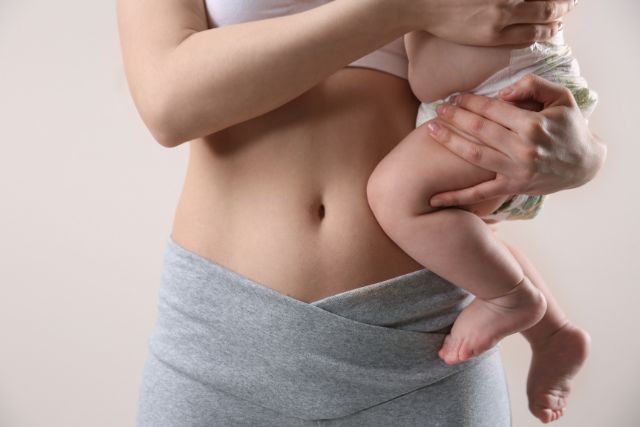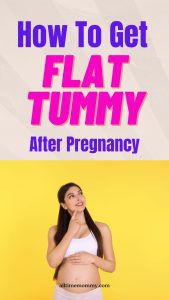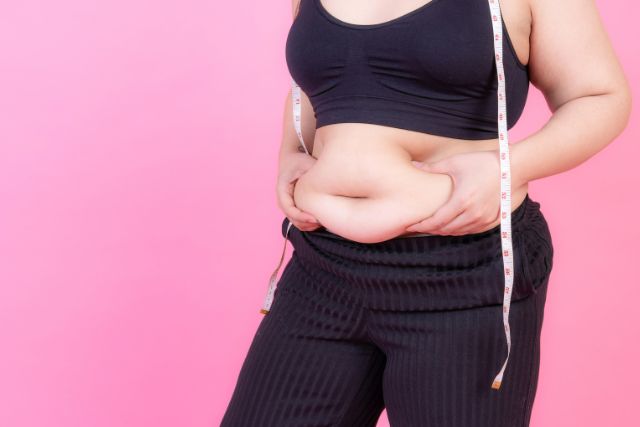Tips for flat tummy after pregnancy. Discover what to do, what to eat, and what to avoid, so you can regain your pre-pregnant tummy faster.
Is postpartum belly making you yearn for the days of a flat tummy?
Mama, I feel you.
A pregnancy pouch can make you think twice before looking at yourself in the mirror.
It can make your cute clothes lie in a closet for ages, not to mention the emotional damage it bestows on your self-esteem.
But is that all about your postpartum belly?
No mama.
While the Postpartum belly may seem like a thorn in the flesh, it’s a stump of a miraculous journey you’ve walked successfully.
It’s not something to cause you sleepless nights but rather a constant reminder of a life that you brought forth.
However, some exceptions may need attention.
Why? Because…
According to the CDC, about half of all expectant mothers gain more than the recommended amount of weight during pregnancy.
The CDC recommends that a woman carrying one baby in her tummy should gain about 25 to 35 pounds.
This may be about 11.5 to 16 kg only.
But is this even the case?
Some of us only realize that we’ve added so much when we can no longer wear our favourite clothes after birth.
At times, we may wonder,
Was it not just the baby’s doing that made me add so much weight?
Hmmmmm…
The baby contributes quite a lot to how we weigh during pregnancy, but that is not all.
So,
What Constitutes Pregnancy Weight Gain?
According to a study, pregnancy weight gain consists of the following:
- The baby
- Placenta
- Amniotic fluid
- Breast tissue
- Blood
- Uterus enlargement
- Extra fat stores, which are typically reserved for birth and breastfeeding needs.
- Excess unhealthy body fat
Are there consequences of keeping on some of this extra weight after pregnancy?
Yes, mama. Having excess baby weight may result in;
- Increased risk of preeclampsia
- Increased risk of gestational diabetes
- Increased risk of heart disease
So,
What is the way forward?
Shed off the excess pregnancy weight.
If you’re a new mom on a mission to reclaim your pre-baby body and feel incredible in your skin, you’re in the right place.
Welcome to a transformative journey where we unravel the most effective and empowering ‘Tips for a Flat Tummy after Pregnancy.’
From targeted exercises that ignite your core to nutrition secrets that fuel your vitality, join us as we navigate the path to a stronger, healthier, and more confident you.
But before then,
Why Does Your Belly Stay Big After Giving Birth?
On average, a new mom may lose up to 13 pounds (6 kg) right after childbirth.
And if this is so,
Why do you still look so heavy a few weeks after leaving the labour ward?
Well, Mama.
First, your uterus is still enlarged
It takes time for your uterus to shrink back to its pre-pregnancy size after childbirth.
The process, known as involution, can take several weeks or even months.
Be patient and allow the hormones to heal your body naturally.
You still have weak abdominal muscles.
Pregnancy can stretch and weaken your abdominal muscles.
It takes time and targeted exercises to regain muscle tone, which is necessary for strengthening the abdominal area.
You still have stretched skin
The skin on your belly may have stretched during pregnancy, resulting in loose with a bit of stretch marks after birth.
It may take time for your skin to regain its elasticity and contract to its previous state, leaving your tummy wobbling for some time.
You still have Water Retention issues
Postpartum water retention, also known as postpartum edema or swelling, occurs due to increased progesterone hormones.
After delivery, your body will continue to hold on to water due to hormonal changes.
This condition may cause swelling in your hands, arms, feet, ankles, and legs for about a week after childbirth.
Increased baby fat storage
Some women may have stored extra fat during pregnancy, particularly around the abdominal area.
Losing this fat can take time and a combination of healthy eating and exercise.
The first trimester is the most difficult to stay in shape because your body is adjusting to the hormone changes of pregnancy.
Your estrogen and progesterone levels are fluctuating, which affects how much you’re eating.
You may be hungrier than usual or in need of more frequent meals. Either way, it’s essential to understand that you’ll likely gain weight during this time, as your baby needs extra calories for development.
You may be suffering from Diastasis Recti
Diastasis recti is a condition that occurs when the abdominal muscles separate during pregnancy.
The separation of these muscles is to accommodate the growing uterus.
Closing the gap and restoring muscle integrity can take time plus doing specific exercises.
Genetics
Genetics affect how your body responds to pregnancy and how quickly it returns to its pre-pregnancy state.
Hormone changes
Certain maternal hormones have a significant effect on weight gain and fat storage.
High oestrogen levels during pregnancy can cause significant fat gain on the belly and thighs.
This is due to the body preparing for breastfeeding and ensuring the baby is safe during pregnancy.
High Stress levels due to ‘baby blues’
A direct link exists between being constantly stressed and storing high-fat levels in the belly area.
This is due to the stress-related hormone known as cortisol.
Cortisol is elevated during high-pressure situations and causes the body to ‘lock down’ what it has as a defense mechanism.
Managing cortisol through meditation and mindfulness techniques can help with this.
Poor diet during and after pregnancy
Most of the time, our body fat levels are determined in the kitchen.
Our bodies struggle to adapt when we have poor eating habits, such as too many refined carbohydrates or too much sugar.
They end up storing fat as default.
11 Tips for Flat Tummy After Pregnancy
1. Eat a More Soluble Fibre Diet
I know you’ve just had a baby and must eat for two people. However, losing your postpartum belly requires some level of discipline regarding diet.
While we discourage crash diets for breastfeeding women, monitoring your calorie intake can go a long way in helping you lose that stubborn baby pouch.
Ensure you eat more soluble fibre foods to help you feel fuller for longer.
Why?
Studies show that soluble fibre can slow digestion and reduce hunger hormone levels.
Soluble fibres are excellent water absorbers.
During digestion, they also form a gel that helps slow down food movement as it passes through your digestive tract.
This can make you feel full for an extended period, naturally reducing the amount of calorie intake in a day.
Sources of soluble fibre include
- fruits and vegetables
- legumes
- oats
- barley
Tips from a nutritionist
- Make your lactation snack from whole grains like oats, brewer’s yeast, flaxseeds or barley without much-added sugar to increase your milk supply and reduce your postpartum belly.
- Drink your breastfeeding porridges made from whole grains like oats porridge in the morning instead of refined carbs.
- Eat more of Vegetable, beans, and barley soup to cut off your hunger.
2. Eat a High-Protein Diet to Boost Your Metabolic Rate
Protein is very crucial for a breastfeeding mother. Besides helping with postpartum body healing, a high-protein diet decreases appetite and increases fullness.
This will naturally decrease your calorie intake for faster weight loss postpartum belly pouch reduction.
According to research, proteins can also boost your metabolic rate due to a more significant thermal effect.
This is because your body uses more energy to digest proteins than other foods.
As such, consuming more proteins in your diet may burn more calories.
Healthy protein sources include:
- lean meats
- eggs
- low mercury fish
- legumes
- nuts and seeds
- dairy products
3. Have a Pre-Meal Water Intake
For breastfeeding women, there is no debate that staying hydrated is necessary to replace fluids lost through milk production.
Lack of drinking enough water can make you feel exhausted with impaired concentration.
Sometimes you may experience loss of strength and general fatigue if you do not get enough water while breastfeeding.
According to the CDC, choosing water over just one 20-ounce sweetened beverage can save you 240 calories.
A good strategy that worked for me was sipping water before meals.
One study shows that pre-meal water consumption may help naturally reduce calorie intake, supporting healthy weight management and reduction of postpartum belly.
4. Exclusively Breastfeed If You Can
According to a study, exclusively breastfeeding for at least three months may help you lose at least 3.2 pounds at 12 months postpartum.
This is because nursing a baby tends to burn, on average, 500 additional calories daily.
This is the equivalent of performing 45–60 minutes of medium-intensity physical exercise.
And not just that.
Breastfeeding increases the production of oxytocin hormone.
This hormone lets your uterus contract after birth, reducing bleeding and relaxing pelvic connective tissue.
Additionally, oxytocin acts on homeostatic, a reward and impulse mechanism that control brain circuitry to reduce caloric intake, particularly of more palatable foods.
While this holds, breastfeeding doesn’t help on its own. It needs to be fueled with a proper diet and moderate exercise.
Related:
5. Do a Lot of Diaphragmatic Breathing for Muscle Toning
Diaphragmatic breathing, best known as belly breathing, involves taking deep breaths into the belly.
This helps promote relaxation, reduce stress, and improve core strength.
Try to do diaphragmatic breathing in the first few days after birth.
Deep belly breathing with abdominal contraction helps relax muscles, and it starts strengthening and toning your abs and belly.
Here’s how it’s done:
- You can either sit or lie down on your back
- Place one hand on your chest and the other on the hand below your rib cage.
- Inhale deeply through your nose. This will allow your belly to expand as you breathe in.
- Exhale slowly through your mouth. Doing so allows your abdomen to sink back down.
- Repeat for about 5 to 10 minutes a day for a few weeks.
- You can gradually increase the length of your inhalations and exhalations over time.
6. Belly Binding to Improve Posture and Alignment
Belly binding is an ancient practice to help support and strengthen abdominal muscles after birth.
Beside is one of the best tips for flat tummy after pregnancy.
Supporting your abdominal muscle will help reduce the risk of developing diastasis recti.
And not just that.
When done correctly, timely belly binding can help your uterus shrink to its original position and reduce your postpartum belly size.
According to a study, postpartum belly binding can help reduce the feeling of distress and increase your mobility.
Many doulas recommend binding your belly for about 8 hours daily in the first 40 days to reap the maximum benefits for your postpartum belly.
Related:
7. Abdominal Exercises and Specific Yoga Moves
Doing muscle toning exercises has been by far one of my favourite tips for flat tummy after pregnancy.
These exercises improve the appearance of a chubby stomach after birth and can help you lose baby weight so fast.
You can start with specific yoga moves like the cat and cow pose, a few sessions in a day.
This will strengthen your AB muscles, relax your tummy and ease back pains.
Afterwards, you can engage in abdominal exercises for tummy tightening like;
Plunks
Plunks can help you burn calories and flatten your postpartum belly by burning baby fats around your abdominal area.
You may do forearm plank, side plank or one-arm plank.
For example;
To Do a Fore arm plank;
- Lie down on your tummy assuming a push up position
- Support your body with your forearms and toes.
- Suck in your belly to tighten your abs muscles.
- Ensure your body remains straight from head to heels.
- Clench your glutes or tighten your buttocks and hold for 10 seconds.
- Repeat the exercise at least twice in a day.
Scissor kicks
- Lie on your back on a comfortable mat.
- Lift both legs off the floor
- Then scissor your legs by lowering and lifting them alternately.
- Do 15 to 20 repetitions daily.
Bicycle Crunches
The bicycle crunch is one of the most effectively exercises for reducing postpartum belly.
Why?
Because it engages three of your major core muscle groups all at the same time.
However, it takes work.
- Lie on your back with your hands behind your head. Ensure your neck slightly lifted and your heels stretched out in front of you.
- Bent your knees at a 90-degree angle
- With your upper body twisting in both directions, move your legs like you’re riding a bicycle.
- You may consider doing this exercise after six weeks postpartum period.
8. Postpartum Skin Massage and Collagen Supplements
According to this study, using oil and creams for postpartum skin massage can help improve your skin appearance.
Massaging your tummy after birth with oil or creams may help increase collagen production and improve skin elasticity.
This may help firm and tighten the skin, especially around your belly.
Additionally, Collagen supplements can help boost skin elasticity, hydration, and dermal collagen density.
All these factors may improve the appearance of loose skin to make you more attractive.
Related:
- 7 Best Postpartum Skin Firming Cream
- 9 Surprisingly Effective Natural Remedies For Stretchmarks After Pregnancy
9. Get Active and Moving
Do you know you can still lose weight by doing nothing but taking care of your baby at home?
Mama, after six weeks and your doctor’s clearance, you may consider doing some house jobs like;
- Cleaning your house: Simple household chores like cleaning the house, doing laundry, cooking, and dishwashing can help you lose at least 200 calories daily.
- Childcare activities at home, like lifting or holding your baby, bathing and dressing your baby, may help you burn about 100 calories in a day
- Evening walks: Walking fast and pushing a stroller with a baby may help you burn about 250 calories in a day.
10. Eat Healthy Fats
Healthy or unsaturated Fats are a type of lipid that remain liquid at room temperature.
You can get healthy fats from plant-based foods like walnuts, flax seeds, chia seeds, soybeans, avocados and olives.
I mean snacking on avocado or a few nuts can in between your meals may be an excellent strategy to reduce your portions when eating your main meals.
it increases your satiety for extended period.
Also, you can get this oil from fatty fish like sardines, salmon, and mackerel.
Studies show that fish oil supplements may significantly reduce the production of cortisol hormones associated with fat storage.
In fact, according to this research, people who took fish oil supplements lost about 1.1 pounds or 0.5 kg of fat in just six weeks.
Additionally,
Include MCTs Fats in your daily diet.
Another thing you may also need to consider is eating more Medium-chain triglycerides best known as (MCTs).
MCTs are fats that are rapidly broken down and absorbed into the body.
They are found in foods like coconut, palm kernel, butter, and whole milk.
How do these fats help you lose your postpartum belly?
- They increase fullness by increasing the production of peptide YY and leptin. These two hormones can help reduce appetite and increase feelings of fullness, making you eat less calories.
- They are easily absorbed and digested, thus reducing fat storage.
- They Increases your body’s ability to Burn calories.
- MCT-rich diet can result in a greater fat loss around your belly.
11. Get Enough Sleep
I know the baby is around Mama. But do you know that insufficient sleep can increase your postpartum belly size?
According to the Mayo Clinic, poor-quality sleep may increase stress hormone levels called cortisol.
Increased cortisol production, especially in the evenings, may affect insulin sensitivity.
This may decrease insulin sensitivity and trigger the body to store more belly fat.
As such, be sure to create time for sleep, especially at night.
Things to Avoid If You Want To Get A flat Tummy After Pregnancy
- Limit your sodium to reduce water retention
- Reduce saturated fats to lower the risk of lifestyle diseases and increasing belly fat storage.
- Limit the use of added sugars
- Limit simple carbs in your diet.
What can prevent you from losing Postpartum belly pouch?
Doing nothing but just hoping that your body will get back to normal naturally
Losing weight after a baby is like going against the tides.
With a high production of cortisol hormone, you are more likely to feel hungrier.
Sometimes, hormones are involved in eating, and without deliberate control you may add more weight by eating more calories than you actually need.
Not willing to make sacrifices
It would be best to sacrifice some of your favourite foods like simple carbs, sugary snacks . Also be ready to break up with your a Sedentary lifestyle and get moving.
Expecting change to happen quickly
Most women don’t just want to get their bodies back.
I mean, they want to get it back now.
And so you spend much time on the scale, eagerly awaiting a significant drop in numbers.
Mama, you will be disappointed.
Give yourself time.
Thinking that it’s the baby who is making you add weight
Your lifestyle contributes 90% to your weight gain than motherhood.
Stop looking at your little one with stormy eyes and start working on your self.
Not finding your why- right
If you’re only driven by temporary reasons like looks without considering your overall health, losing a considerable amount of weight may be challenging after childbirth.
Take Away
While losing your postpartum belly or getting a flat tummy after pregnancy may seem like an uphill task, it’s still possible.
A proper diet that supplies you with enough calories and nutrients can help you lose stubborn belly fat. Also, get active and moving after your doctor’s clearance.
Did you find this post helpful? Please share with your community and don’t forget to leave a comment.
UP NEXT:
- Waist Size Matters: Here is Why You Should Care More about Your Waist Size as You Age
- 8 Things Health Conscious Women Do To Prevent Urinary Tract Infection
- 33 Things That Make Parenting Life Easier
- How To Stop Breastfeeding a Toddler With Ease and Confidence
DISCLAIMER The information contained in this post is for general information purposes only. I’m not a health practitioner and as such, this information should not be used as a substitute for consultation with your professional service provider.




